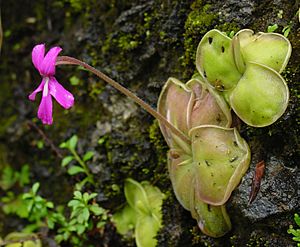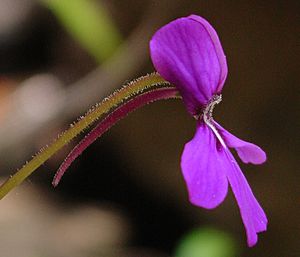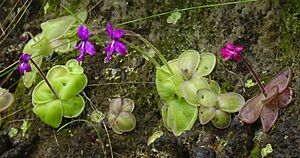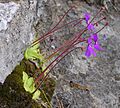Pinguicula moranensis facts for kids
Quick facts for kids Pinguicula moranensis |
|
|---|---|
 |
|
| In habitat in Oaxaca | |
| Scientific classification | |
| Genus: |
Pinguicula
|
| Species: |
moranensis
|
| Varieties | |
|
P. moranensis var. moranensis |
|
| Synonyms | |
|
According to Zamudio (2001) unless otherwise noted.
P. moranensis var. neovolcanica: |
|
Pinguicula moranensis is a special plant known as a carnivorous herb. It's often called a butterwort because its leaves feel a bit greasy or "buttery." This plant grows in El Salvador, Guatemala, Honduras, and Mexico.
It forms flat groups of leaves called rosettes. These leaves can grow up to 10 centimeters (4 inches) long. They are covered in sticky glands that act like flypaper. These glands attract, trap, and digest small insects like flies. The plant uses the nutrients from these insects to help it grow, especially since it lives in soil that doesn't have many nutrients.
Pinguicula moranensis changes its look throughout the year. In summer, it has its sticky, insect-eating leaves. But in winter, when food and water are scarce, it forms a different rosette of small, non-sticky leaves. This helps the plant save energy. Pretty pink, purple, or violet flowers grow on tall stalks up to 25 centimeters (10 inches) long. These flowers appear twice a year.
The plant was first found by explorers Humboldt and Bonpland in Mexico around 1803. A scientist named Carl Sigismund Kunth officially described it in 1817. P. moranensis is very common and widespread. People often grow it because it's a fascinating carnivorous plant with beautiful flowers.
The name Pinguicula comes from the Latin word pinguis, meaning "fat," because of the sticky feel of its leaves. The second part of its name, moranensis, refers to the place where it was first found, Mina de Moran.
Contents
Plant Features
Pinguicula moranensis is a plant that changes its shape with the seasons. This is called being "seasonally dimorphic." It has two different ways of growing during the year.
Summer and Winter Leaves
In the summer, when there's plenty of rain and insects, the plant grows a flat rosette of 6 to 8 leaves. These leaves can be up to 9.5 centimeters (3.75 inches) long. These are the carnivorous "summer leaves." They are covered with sticky glands that catch and digest insects, usually flies.
When the dry season starts around October, these summer leaves are replaced. The plant then forms a "winter rosette" of smaller, thicker leaves. These winter leaves don't have sticky glands and don't eat insects. This resting stage helps the plant survive the winter until the rains return in May.
Flowers and Flowering Time
The plant produces flowers on upright stalks that are 10 to 25 centimeters (4 to 10 inches) long. These stalks are often covered in sticky hairs too, and can even trap small insects! Flowers appear twice a year, once from the summer rosette and again from the winter rosette. This is unusual for Mexican butterworts. In summer, flowers usually show up in June, are most common in August and September, and disappear by October or November.
The flowers have five petals that are joined together at the bottom. The part of the flower that holds the reproductive parts is shaped like a funnel. The petals spread out from there, forming a five-lobed flower. The flowers are usually 30 to 50 millimeters (1.25 to 2 inches) long. Below where the petals join the stem, there's a spur that sticks out backwards.
The flowers can last up to 10 days. Once they are pollinated, they will wilt. After pollination, the plant produces small seed capsules. These capsules are about 5 millimeters (0.2 inches) long and contain many tiny seeds.

The color and shape of the flowers can vary a lot, even among plants from the same area. This makes them interesting for gardeners but sometimes tricky for scientists to classify! Flower colors range from pink to purple. Some flowers might have a white center or white stripes on their petals. Rarely, white-flowered forms are also found.
How it Catches Food
The summer leaves of P. moranensis are smooth, firm, and a bit thick. Their color can range from bright yellow-green to maroon. They are usually oval or roundish, about 5.5 to 13 centimeters (2 to 5 inches) long.
These leaves are covered with two types of glands:
- Stalked glands: These glands have a tiny stalk and produce a sticky, gooey liquid called mucilage. This liquid forms visible droplets on the leaf surface, making it look wet. This wet look might trick insects into thinking it's water. When an insect lands on the leaf, it gets stuck in the mucilage. The more the insect struggles, the more mucilage is released, trapping it even more. The edges of the leaf can also curl up slightly to bring more glands into contact with the trapped insect.
- Flat glands: These glands lie flat on the leaf surface. Once an insect is trapped and digestion starts, these glands release special chemicals called enzymes. These enzymes break down the soft parts of the insect's body. The plant then absorbs these nutrients through tiny holes in its leaf surface. Only the hard outer shell of the insect is left behind.
Because the leaves have these tiny holes for absorbing nutrients, the plant needs to live in humid places. This helps it avoid drying out. Making these sticky and digestive glands also takes a lot of energy. Scientists have found that the number of capture glands is highest where there are fewer insects to catch. But the number of digestive glands is higher where there are more insects. This shows how the plant adapts to its environment.
The winter rosette is much smaller, about 2 to 5 centimeters (0.75 to 2 inches) wide. It has 60 to 100 or more small, thick leaves. These leaves are 10 to 30 millimeters (0.375 to 1.25 inches) long and are covered with fine hairs. The winter rosette can be open or look like a compact bulb, depending on the specific type of P. moranensis.
Where it Lives
Pinguicula moranensis is the most widespread type of butterwort in Mexico. You can find it in almost all the major mountain ranges there. It also grows in Guatemala, El Salvador, and Honduras.
This plant lives in mountainous areas, from about 800 to 3200 meters (2600 to 10500 feet) high. It often grows on sedimentary rocks from the Cretaceous period. However, one specific type, P. moranensis var. neovolcanica, prefers to grow on igneous rocks, which are formed from volcanic activity.
Pinguicula moranensis usually grows in forests with oak and pine trees. But it can also be found in tropical forests and dry shrublands, especially in humid places like stream banks, gullies, or rocky cliffs. It loves shady, moist spots.
Because it can get nutrients from insects, it can grow in poor soils where other plants might struggle. So, you often see it in disturbed areas or on steep hillsides. Its roots mainly help it stay in place, so it doesn't need much soil. You can find dense groups of these plants clinging to rocks, moss, or even growing on tree trunks like an air plant.

Growing Pinguicula moranensis
Pinguicula moranensis is a very popular plant to grow at home. This is because it's quite large, has beautiful flowers, and is relatively easy to care for in a pot.
Most growers use a loose soil mix. This mix often includes things like washed sand, perlite, vermiculite, peat moss, and gypsum. The soil needs to drain well. You should water it regularly with distilled water during the summer. But when the plant goes into its winter resting stage, you should water it only very rarely.
This plant grows well on sunny windowsills, under special plant lights, or in warm greenhouses.
Plant Hybrids and Cultivars
While P. moranensis doesn't naturally mix with other plants in the wild, it does so easily when grown by people. Because of this, many new types (called cultivars) have been created and officially recognized. These are often crosses between P. moranensis and other Pinguicula species.
| cultivar name | parentage | description |
|---|---|---|
| Pinguicula 'George Sargent' Hort. Slack | P. moranensis × gypsicola | Lilac flowers, strap-shaped leaves, large winter rosettes. |
| Pinguicula 'Hameln' Hort. Studnicka | P. gypsicola × moranensis | Wider, P. moranensis like foliage. |
| Pinguicula 'John Rizzi' Hort. D'Amato | P. moranensis × ? | Large, full flowers; oval, marginless undulating leaves. |
| Pinguicula 'L'Hautil' Hort. L.Legendre & S.Lavayssiere | P. (ehlersiae × moranensis) × moranensis | Two forms ("Grande" and "Petite"). P. 'Sethos' × P. 'Huahuapan' |
| Pinguicula 'Mitla' Hort. Studnicka | P. gypsicola × moranensis | Wider, P. moranensis like foliage. |
| Pinguicula 'Pirouette' Hort. J.Brittnacher, B.Meyers-Rice & L.Song | P. agnata × (moranensis × ehlersiae) | Hardy clone, attractive rosettes of pink leaves. |
| Pinguicula 'Sethos' Hort. Slack | P. ehlersiae × moranensis | Large flowers with a white star-like center. |
| Pinguicula 'Weser' Hort. Slack | P. moranensis × ehlersiae | Large flowers with single white streak down central lower lobe and dark veins. |
Also, three specific types of P. moranensis have been registered as cultivars:
| cultivar name | origin | description |
|---|---|---|
| Pinguicula 'Huahuapan' Hort. Slack | Huajuapan de León, Oaxaca, Mexico | Lilac-pink flowers with crimson touches at their base. |
| Pinguicula 'Libelulita' Hort. Rice & Salvia | southern Mexico | Square-tipped petals, pale purple at edges darkening to deep velvet-red near base, heavily veined, white center. |
| Pinguicula 'Vera Cruz' Hort. Slack | Veracruz, Mexico | Deep rose with basal markings. |
Images for kids
-
Alexander von Humboldt was one of the first to collect P. moranensis.
See also
 In Spanish: Violeta de barranca para niños
In Spanish: Violeta de barranca para niños










